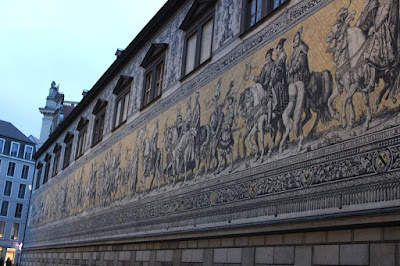Day 36
There are only a couple of pretty ordinary restaruants out
in our part of Dresden so we decided to head in late, do our touristing and
have dinner in town before coming home.
Tram #9 from Querallee to Palaisplatz did the honours today.

Our itinerary today contained only one stop – the Residenzschloss
(Dresden Royal Palace). We shelled out
for the standard #1 ticket $ 12 euro each.
This gave us access to everything except the Historical Green Vault and
as it turned out we couldn’t have managed to add this without our heads
exploding. The first building on the
site went up in 1485 and from then to the end of WW1 it was the home of the
King of Saxony. The Palace was smashed
by the 1945 bombing and initial plans by the DDR government to demolish it were
met with stiff resistance. Little work
was done other than to sling a temporary roof over it in the Iron Curtain years
and what we saw today is the result of less than 30 years of work – its astonishing…
there are no other words to describe what has been re-built from the rubble of
1945.


You enter the museum up the ‘English Staircase’ – a graceful
square staircase built in 1692 that takes you up through all levels of the
palace. Originally just for the Royal
family it was renamed the English Staircase in 1693 when the then elector
Johann Georg IV was made a Knight of the Garter. Severely damaged in a fire in 1771 it was
rebuilt, before being almost completely destroyed in the 1945 bombing. Rebuilding work finished in 2010
 |
| The English Staircase in 1945 |
 |
| Finally cleared of rubble in 2005 |
 |
| And as it is today - restoration/rebuilding finished in 2010 |
You enter the New
Green Vault – little brother to the Historical Green Vault via the Princes
Gallery – a long room lined with busts of the Saxon Kings and Paintings of
about a dozen electors from the 16 & 1700’s.
The New green Vault is the ‘lesser’ of the collection put
together over several hundred years by a succession of Kings of Saxony and the
Electors of Saxony. The 1600’s in
Germany was a time of serious one-up’s-man-ship and each time something special
happened – birth, birthday, marriage, crowning the family added amazing
treasures to their collection which they housed in the Green Vault. They amassed a priceless collection of works
by court jewellers, turners, cabinet makers, carvers etc.
There are over 1000 works in the New Green Vault – here are
some of our favourites (for various reasons – jaw-dropping, amazing artisan
skill and just plain ‘you have to be kidding’)
 |
| Gold Cabinet |
 |
| Rolling ball clock 1603 |
 |
| Sandstone relief carving of the nativity - 1588 ... the detail is astonishing given it is only about 25cm across |
 |
| Gold wall mirror 1587 |
 |
| Automaton - Centaur & Diana - the dogs heads nodded and the Centaur fired his bow |
 |
| Ivory Ship 1620 |
 |
| WInner of the 'Just plain wierd' award .. Dancing Dwarf - his body is a mis-shapen pearl 4" tall. 1706 |
 |
| Coffee set 1697 |
 |
| The Famed Green Diamond - only known one of its kind - 41carats surrounded by 411 other diamonds. Nice little trinket |
 |
| Exquisitely embroidered mitre Archbishop of Brandenburg 1490 |
After almost 2hours in the Green Vault we headed for the
Renaissance Wing where the display of Electoral costume from the 1600’s had me
utterly drooling. Original garments
preserved due to the foresight of Elector August of Saxony (1526-1586) who
ordered that his brothers garments be preserved. Subsequent electors added their garments.
 |
| Red silk suit Duke Johann Fredrich I of Saxony 1540 |
 |
| Parade Garment Elector Christian II blue silk 1610 |
 |
| Red silk garment Prince Johann George of Saxony 1617 |
 |
| close up of the embroidery |
 |
| Parade Dress Electress Magdelena Sybilla of Saxony 1650 |
 |
| Parade Cape Elector Johann Grorg 1611 |
Life in Renaissance Germany is displayed via furniture and
tools from around 1600.
 |
| Entertainment table |
 |
| Embroidery box late 1650's |
The Electors of Saxony had already developed a taste for
collecting by the time they had any interactions with the Ottomans. The collection features a full sized tent,
weaponry (which was really hard to photograph due to shadows and lighting) and
some magnificent ceremonial horse trappings.
The Giants Hall is now home to an astonishing collection of
armour – both ceremonial/parade and for actual battle use.
 |
| Foot tourney - across a fence, upper body armour only |
 |
| Parade Armour King Erik XIV of Sweden 1563 |
 |
| Childrens armour for the sons of Elector Christian I of Saxony 1590 |
It was almost 4pm when we called it quits on the collections
of the Residenzschloss. Possibly the most amazing museum of its kind either of
us have ever seen. Quite by accident we stumbled on a medieval fair (pretty
sure its there all the time) and stopped for a very late lunch before taking a
quick look in the fading light at the mural of Saxon Kings which adorns one of
the back walls of the Palace complex.
Made of 25,000 Meissen porcelain tiles it covers all kings from the 1300’s
to 1918.
Schnitzel for dinner in one of the late opening shopping
centres and the #9 tram home.














































No comments:
Post a Comment